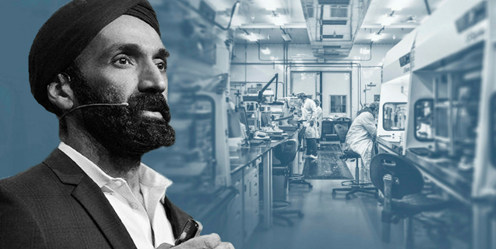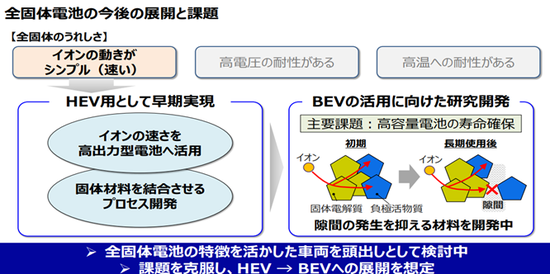固态电池恐怕只是一场梦
“固态电池普及之日,就是燃油车退出历史舞台之时。”
这是多年前流传于新能源行业的一句话。大众汽车电芯中心负责人弗兰克·布洛梅甚至将固态电池称为锂离子电池的“最终篇章”,和可控核聚变民用化之前的能源设备终点。
仿佛谁能率先造出固态电池并实现其大规模商业化,谁就将获得锂电技术的“圣杯”,成为能量魔方的解密者,和全球新能源行业的霸主。
正是在这样的背景下,全球新能源从业者、分析师和投资人们都开始疯狂追逐这一方向。以 QuantumScape、Solid Power 等为代表的美国创业公司,丰田、日产、松下等日本汽车和化工巨头,以及一些中国电化学材料方面的企业,纷纷加入了领域内的较量。
QuantumScape(简称QS)是其中的代表性企业,其背后的投资者也是阵容强大,包括大众汽车集团和比尔·盖茨。QS也不负众望,在2020年上市前,QS已经验证了他们的单层电池在室温加压的情况下,以1C的速率充放电循环1000次后还可以保持初始储能量的90%。同时QS宣布他们已与大众合作启动生产线的建设,预计在2025年可投产。这颗卫星直接把QS的股价推高了10倍。
然而,狂欢之后,越来越多的人提出质疑,毕竟单层电池距离实际应用还非常遥远,即便技术问题解决了,能否商用化也成问题。
QuantumScape 采用的无机氧化物固态电解质层,重量是传统锂电隔膜的10倍以上,由于固态电解质离子电导率低,影响了放电倍率和低温工况下的性能。该公司不得不在电池正极侧添加不少于20%质量的氧化物提供离子电导。
这些非活性物质的增加,使得电池的能量密度降低,有行业资深专家告诉品驾,QuantumScape 电池能量密度难以超过350Wh/kg,无法和主流传统锂电高端产品水平拉开差距,想要达到固态电池理论能量密度的峰值水平,更是难上加难。
事实上,人们认为固态电池是因为固态带来的高能量密度是完全错误的。真正提升电池能量密度的关键在于使用硅或者锂金属负极。这两种负极也正在用于液态电池,以提升能量密度。
另一方面,固态电池的更高安全级别同样经不起推敲。人们普遍认为,固态电解质绝缘性好,不可燃、不挥发,即便发生了形变,也不会导致电解质外漏,但物理性能的安全只是电池安全的一个侧面,其他任何一个侧面的高危都可能让固态等于不安全。
美国能源部的一项研究发现,全固态电池在因为锂枝晶引发短路的温度比传统锂离子电池更高,而热量的释放可能会通过易燃包装或者附近的其他材料而起火;并且当固态电解质层因为各种原因而完整性受损的时候,反应更是会释放巨大的热量。有趣的是,QuantumScape公司的万圣节活动上,连续很多年都会有人假扮成一个锂枝晶形状的怪物。

锂枝晶
更值得人们关注的是,QuantumScape 采用的氧化物片电解质硬度太高,不得不增加凝胶电解质来改善界面,而这样做将会降低固态电池的本征安全性。尤其是其氧化物片由于金属锂沉积的临界电流密度很小,在未来使用中将很容易发生短路。
QuantumScape 在去年年底也对电池安全含糊其辞,当时该公司勉强造出了首批原型固态电池并交付给汽车客户,创始人、CEO 兼董事长 Jagdeep Singh 提到这批电池产品的可靠性方面“仍有很大提升空间”。

QuantumScape CEO Jagdeep Singh图片来源:金融时报
不仅如此,量产也仍有许多问题没有解决。虽然氧化物基电解质这种材料在空气中具有更好的稳定性,但对制造工艺要求很高,需要800摄氏度以上的高温烧结才可以致密成型,对于大尺寸、超薄和无缺陷的陶瓷制备工艺有着极高的要求,对电池规模化制造带来了更大的挑战。
在生产环境和原材料纯度方面,全固态电池的要求更是比传统锂电更高。批量生产大尺寸的电解质薄膜可能存在困难,因此全固态电池的量产初期或只能小规模生产,用于一些对于成本容忍度更高的领域。韩国新能源研究机构 SNE报告指出,即便到了量产阶段,全固态电池的成本至少也是锂离子电池的两倍,跟新能源汽车行业追求的“降本”背道而驰。
固态电池的狂欢盛宴里,最聪明的资本最先冷静下来。同样在去年底,摩根士丹利分析师Adam Jonas发布研报,将QS评级从“持股观望”下调至“减持”,并将目标价从12美元下调至仅4美元,创华尔街新低。原因包括规模化和获得整车厂认可的时间线的不确定性,以及公司面临更困难的融资环境。Adam Jonas表示,虽然固态电池可能仍然代表着能源存储的未来,但事实证明,实现这一目标的道路比我们和市场预期的更困难,也更遥远。
由于市值也不断脱水,股价从高位的132美元跌至今天的7美元,QS公司也开始裁员,似乎进入了 Gartner 技术成熟度曲线的“泡沫破裂谷底期”。结果,环绕在这匹曾经的黑马周围的泡沫,开始崩塌。
在QS仍然在技术和资本的双难中苦苦挣扎的同时,美国新能源汽车品牌菲斯克已经宣布放弃研发固态电池的计划,转而推出搭载液态锂离子电池的普通电动车。许多人或许还记得2018年,该公司就表示将在数月之内量产固态电池。如今该公司创始人只能用这样的解释来掩盖当初的尴尬,“固态电池是一种这样的技术,当你觉得你已经完成了90%,几乎达到目标时,然后你意识到剩下的10%比前面的90%困难得多。”
丰田的固态电池故事里跳票是个关键词。在新能源方面一直押注油电混动路线,导致纯电技术落后的丰田,一直希望通过提早布局固态电池技术进行超车。其布局固态电池最早可以追溯到2008年,当时该公司宣布和英国创业公司伊利卡 (Ilika) 合作共同研发固态电池材料。
10年过去了,丰田在固态电池上的合作伙伴少说也有了七八家,甚至连这方面的专利都已经累积到了1300多项,数量遥遥领先,是排名2-5的四家日韩企业的相加之和,可惜的是技术到量产的难度不亚于一次西天取经。在前年一场名为“2030电池战略会”的活动上,丰田表示在高能量密度的全固态电池方面研发进展不乐观,在合适的硫化物电解质材料这一关键课题上一直未能破局。

图片来源:丰田
在技术困难无法攻克的背景下,丰田不得不一再推迟全固态产品的量产,其2019年就表示,将在2020年东京奥运会时推出一款搭载固态电池的新能源车型,然而即便奥运会推迟了一年,给了丰田更多的时间,消费者仍然未能等到固态电池搭载车型。同时在商业化方面选了一条令人扶额的路线:将固态电池技术优先投放混动汽车产品,而非面向纯电车型一步到位。
考虑到电动化,特别是纯电化在中国已经形成了不可阻挡的趋势,燃油车的黄昏壮丽,纯电车型的曙光刺眼,让非增程混动车型的市场前景一片黯淡。加之丰田本身的车辆技术迭代周期太长,普遍达到4-5年;其唯一的一辆纯电车型 bZ4X(配置|询价) 初战告捷,又遭遇大规模召回(尽管是非电池原因),在前几天终于官宣项目彻底停产。
丰田的决策,再次令人感受到了这家日本汽车巨头在新能源时代的无所适从,尽管丰田表示要在2025年前推出固态电池。但“狼来了的故事”使人不得不降低对其在固态电池技术上的预期。
留给丰田兑现承诺的时间或许已经不多,在刚刚过去的上海车展宁德时代已经发布了凝聚态电池,最高500Wh/kg的高比能、高安全,关键在今年就可量产。因此更大的可能是,凝聚态装车后,固态电池或许将彻底失去商业化可能性。
如今固态电池这个曾被万众期待的终极电池技术,已经难再撑得起燃油车“终结者”、锂电“圣杯”的名号。它看起来越来越像一群人在错误的技术路线上,共同做了一场梦。
然而梦醒时分已到。
The day when solid-state batteries become popular is the time when fuel powered vehicles retire from the historical stage
This is a saying that circulated in the new energy industry many years ago. Frank Blome, the head of Volkswagen Battery Cell Center, even called solid state batteries the "final chapter" of lithium-ion batteries, and the end of energy equipment before the commercialization of controllable nuclear fusion.
It seems that whoever can first create solid-state batteries and achieve their large-scale commercialization will obtain the "Holy Grail" of lithium-ion technology, become the decipher of the energy cube, and the global leader of the new energy industry.
It is against this backdrop that global new energy practitioners, analysts, and investors are all crazily pursuing this direction. American startups such as Quantum Scape and Solid Power, Japanese automotive and chemical giants such as Toyota, Nissan, and Panasonic, as well as some Chinese companies in the field of electrochemical materials, have joined the competition in the field.
Quantum Scape (QS for short) is one of the representative enterprises, and the investors behind it are also strong, including Volkswagen Group and Bill Gates. QS also lived up to expectations. Prior to its launch in 2020, QS had verified that their single-layer batteries could maintain 90% of their initial energy storage after 1000 cycles of charging and discharging at a rate of 1C under room temperature pressure. Meanwhile, QS announced that they have partnered with Volkswagen to start the construction of the production line, which is expected to be put into production by 2025. This satellite directly pushed up QS's stock price by 10 times.
However, after the carnival, more and more people are questioning whether single-layer batteries are commercially viable even if technical issues are resolved, as they are still very far from practical applications.
The inorganic oxide solid electrolyte layer used by QuantumScape has a weight more than 10 times that of traditional lithium battery separators. Due to the low ion conductivity of the solid electrolyte, it affects the discharge rate and performance under low temperature conditions. The company has to add at least 20% mass of oxide on the positive side of the battery to provide ion conductivity.
The increase of these non active substances has led to a decrease in the energy density of the battery. A senior industry expert has told Pinjia that the energy density of QuantumScape batteries cannot exceed 350Wh/kg, making it difficult to widen the gap with mainstream traditional high-end lithium battery products. It is even more difficult to reach the peak theoretical energy density level of solid-state batteries.
In fact, it is completely wrong to believe that solid-state batteries are due to the high energy density they bring. The key to truly improving battery energy density is the use of silicon or lithium metal negative electrodes. These two types of negative electrodes are also being used in liquid batteries to increase energy density.
On the other hand, the higher safety level of solid-state batteries also cannot withstand scrutiny. It is widely believed that solid electrolytes have good insulation, are not flammable or volatile, and even if deformation occurs, they will not cause electrolyte leakage. However, the safety of physical performance is only one aspect of battery safety, and any other high-risk aspect may make solid electrolytes unsafe.
A study by the United States Department of Energy found that the temperature of all solid state batteries is higher than that of traditional lithium-ion batteries when lithium dendrites cause short circuits, and the heat release may ignite through flammable packaging or other nearby materials; And when the integrity of the solid electrolyte layer is damaged due to various reasons, the reaction will release enormous heat. Interestingly, at QuantumScape's Halloween event, for many years in a row, someone disguises themselves as a lithium dendrite shaped monster.
Solid state batteries are facing global production difficulties, and the "Holy Grail" of lithium-ion batteries may just be a dream
Lithium dendrite
What deserves more attention is that the hardness of oxide sheet electrolyte used by Quantum Scape is too high, and gel electrolyte has to be added to improve the interface, which will reduce the intrinsic safety of solid state batteries. Especially due to the low critical current density of lithium metal deposition, its oxide sheets are prone to short circuits in future use.
QuantumScape was also hesitant about battery safety at the end of last year, when the company barely produced the first batch of prototype solid-state batteries and delivered them to automotive customers. Founder, CEO, and Chairman Jagdeep Singh mentioned that there is "still a lot of room for improvement" in the reliability of these battery products.
Solid state batteries are facing global production difficulties, and the "Holy Grail" of lithium-ion batteries may just be a dream
QuantumScape CEO Jagdeep Singh Image source: Financial Times
Moreover, there are still many unresolved issues in mass production. Although oxide based electrolytes have better stability in air, they require high manufacturing process requirements, requiring high-temperature sintering above 800 degrees Celsius to achieve dense molding. They have extremely high requirements for large-scale, ultra-thin, and defect free ceramic preparation processes, posing greater challenges to the large-scale manufacturing of batteries.
In terms of production environment and raw material purity, the requirements for all solid-state batteries are higher than traditional lithium batteries. Mass production of large-sized electrolyte thin films may face difficulties, so the initial stage of mass production of all solid-state batteries may only be small-scale, for use in areas with higher cost tolerance. The SNE report from the South Korean new energy research institution points out that even in the mass production stage, the cost of all solid-state batteries is at least twice that of lithium-ion batteries, which goes against the "cost reduction" pursued by the new energy vehicle industry.
In the carnival of solid-state batteries, the smartest capital is the first to calm down. At the end of last year, Adam Jonas, an analyst at Morgan Stanley, released a research report that downgraded the QS rating from "holding and watching" to "underweight" and lowered the target price from $12 to just $4, setting a new low on Wall Street. The reasons include the uncertainty of scale and the timeline for obtaining recognition from vehicle manufacturers, as well as the company facing a more difficult financing environment. Adam Jonas stated that although solid-state batteries may still represent the future of energy storage, the road to achieving this goal has proven to be more difficult and distant than we and the market expected.
Due to the continuous dehydration of the market value, the stock price dropped from a high of $132 to today's $7. QS also began to lay off employees, which seemed to enter the "bottom period of foam burst" of Gartner's technology maturity curve. As a result, the foam around the once dark horse began to collapse.
While QS is still struggling in the dilemma of technology and capital, American new energy vehicle brand Fisk has announced that it will abandon its plan to develop solid-state batteries and instead launch ordinary electric vehicles equipped with liquid lithium-ion batteries. Many people may still remember 2018 when the company announced that it would mass produce solid-state batteries within a few months. Nowadays, the founder of the company can only use this explanation to cover up the initial embarrassment, "Solid state batteries are a technology where when you feel like you have achieved 90% of your goals, you realize that the remaining 10% is much more difficult than the previous 90%
Ticketing is a keyword in Toyota's solid-state battery story. Toyota, which has been betting on the hybrid route of gasoline and electricity in the field of new energy, has always hoped to overtake by laying out solid-state battery technology in advance, resulting in outdated pure electric technology. Its layout of solid-state batteries can be traced back to 2008, when the company announced a partnership with British startup Ilika to jointly develop solid-state battery materials.
Ten years have passed, and Toyota has at least seven or eight partners in solid-state batteries, and even has accumulated more than 1300 patents in this field, far leading the way in terms of quantity. It is the sum of the four Japanese and Korean companies ranked 2-5. Unfortunately, the difficulty of technology to mass production is no less than a time of learning from the West. At an event called the "2030 Battery Strategy Conference" the year before last, Toyota stated that its research and development progress in high energy density all solid-state batteries was not optimistic, and it has not been able to break through on the key issue of suitable sulfide electrolyte materials.
Solid state batteries are facing global production difficulties, and the "Holy Grail" of lithium-ion batteries may just be a dream
Image source: Toyota
Against the backdrop of technological difficulties that cannot be overcome, Toyota has had to repeatedly delay the mass production of all solid-state products. In 2019, it announced that it would launch a new energy model equipped with solid-state batteries during the 2020 Tokyo Olympics. However, even if the Olympics were postponed by a year, giving Toyota more time, consumers still couldn't wait for solid-state battery equipped models. At the same time, a promising route has been chosen in terms of commercialization: prioritizing solid-state battery technology for hybrid vehicle products, rather than targeting pure electric vehicles in one step.
Considering that electrification, especially pure electrification, has formed an unstoppable trend in China, the magnificent dusk of fuel vehicles and the dazzling dawn of pure electric models have made the market prospects of non extended range hybrid models bleak. In addition, Toyota's own vehicle technology iteration cycle is too long, generally reaching 4-5 years; Its only pure electric vehicle, the bZ4X (configuration | inquiry), won its initial battle and suffered a large-scale recall (although it was not due to battery reasons). The project was finally officially announced to be completely discontinued a few days ago.
Toyota's decision once again gives a sense of the Japanese automotive giant's helplessness in the new energy era, despite Toyota's stated intention to launch solid-state batteries before 2025. But the story of the wolf coming forced people to lower their expectations for solid-state battery technology.
There may not be much time left for Toyota to fulfill its promises. At the recently passed Shanghai Auto Show, Ningde Times has released condensed state batteries with a high specific energy and high safety of up to 500Wh/kg, which can be mass-produced this year. Therefore, it is more likely that after the condensed matter is loaded into vehicles, solid-state batteries may completely lose the possibility of commercialization.
Nowadays, solid-state batteries, the ultimate battery technology that has been widely anticipated, can no longer afford the titles of "Terminator" for gasoline vehicles and "Holy Grail" for lithium-ion batteries. It looks increasingly like a group of people dreaming together on the wrong technical path.
However, it was already time to wake up from the dream.

